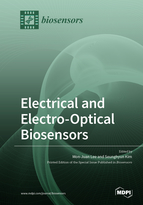Electrical and Electro-Optical Biosensors
A special issue of Biosensors (ISSN 2079-6374). This special issue belongs to the section "Biosensor and Bioelectronic Devices".
Deadline for manuscript submissions: closed (15 September 2021) | Viewed by 36174
Special Issue Editors
Interests: biosensors; liquid crystal; cancer biomarker; aptamer; stem cells; nanobiomaterials
Special Issue Information
Dear colleagues,
Electrical and electro-optical biosensors have received much attention in recent years because of their sensitive detection, simplified procedure, and potential in the development of portable point-of-care devices. These technologies generally rely on the label-free detection of the electrical, electrochemical, and electro-optical signals derived from molecular interactions on sensor surfaces modified with biomolecules. Innovative application of voltammetric, amperometric, capacitance measurements, electrochemical impedance spectroscopy, electrochemical surface plasmon resonance, electrochemical optical waveguide lightmode spectroscopy, transmission spectrometry and dielectric spectrometry on the detection and quantitation of disease-related biomarkers, molecular interactions and activity assays offers challenging research topics yet promising perspectives for researchers working in the field of biosensors.
This Special Issue is devoted to the recent advances in electrical, electrochemical, and electro-optical biosensors, including the design of the electrode and biosensing interfaces, as well as the quantitative approaches for interpreting various electrical signals resulting from the detection of target analytes or molecular binding events. The authors are encouraged to provide clinical evidence or implications that these technologies can be potentially transformed into practical medical devices.
Prof. Dr. Mon-Juan LeeDr. Seunghyun Kim
Guest Editors
Manuscript Submission Information
Manuscripts should be submitted online at www.mdpi.com by registering and logging in to this website. Once you are registered, click here to go to the submission form. Manuscripts can be submitted until the deadline. All submissions that pass pre-check are peer-reviewed. Accepted papers will be published continuously in the journal (as soon as accepted) and will be listed together on the special issue website. Research articles, review articles as well as short communications are invited. For planned papers, a title and short abstract (about 100 words) can be sent to the Editorial Office for announcement on this website.
Submitted manuscripts should not have been published previously, nor be under consideration for publication elsewhere (except conference proceedings papers). All manuscripts are thoroughly refereed through a single-blind peer-review process. A guide for authors and other relevant information for submission of manuscripts is available on the Instructions for Authors page. Biosensors is an international peer-reviewed open access monthly journal published by MDPI.
Please visit the Instructions for Authors page before submitting a manuscript. The Article Processing Charge (APC) for publication in this open access journal is 2700 CHF (Swiss Francs). Submitted papers should be well formatted and use good English. Authors may use MDPI's English editing service prior to publication or during author revisions.
Keywords
- electrical biosensor
- electrochemical biosensor
- electro-optical biosensor
- dielectric biosensor
- Protein
- enzyme
- Immunoassay
- label-free detection
- real-time detection
- lab-on-a-chip devices








